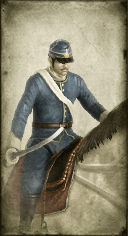
Basic Unit Statistics (can be modified by difficulty level, arts, skills, traits and retainers)
| Recruitment Cost | 1200 | |
| Upkeep Cost | 150 | |
| Melee Attack | 17 | 48% |
| Charge Bonus | 10 | 20% |
| Bonus vs Cavalry | 0 | 0% |
| Melee Defence | 7 | 20% |
| Armour | 2 | 13% |
| Morale | 12 | 24% |
Strengths & Weaknesses
- Very good in melee.
- Good charge.
- Weak against missile attacks and spear units.
- Very good morale.
Abilities
- Wedge Formation - Trained to charge in a wedge formation in order to better penetrate enemy formations
Requires
Description
Japanese bravery and a little French panache can ride down almost any foe.
These guard cavalrymen are a capable force, if they can close with their opponents. Unlike other cavalrymen, they do not simply rely on the shock and impact of their initial attacks to disrupt and defeat enemy units. They should charge home and then remain in close combat, fighting with their sabres. Their training and weaponry make them effective in close combat both on attack and defence. However, they are likely to suffer if sent against yari-armed units, if left exposed to rifle fire, or if subjected to artillery bombardment. Used correctly, however, they will be a magnificent close combat force, able to keep fighting even when taking casualties thanks to their high morale. Despite the fact that modern-pattern rifles and their associated tactics were making swords largely obsolete on the battlefield as the main armament for troops, most European armies continued to issue them to their cavalry soldiers. Swords were not just for show, either: they were considered effective weapons in trained hands if the cavalryman could close with his target. Indeed, development work on new swords would continue in Europe for more than 40 years after the Boshin War. This eventually resulted in a very fine weapon: the British Army's 1908 Pattern cavalry sword, probably the best sword ever generally issued to cavalrymen. This was not a sabre designed for slashing, but a long, straight blade designed to spear a target. Other armies followed, including the US Army with its 1913 design. This sword was the work of George S Patton, now usually remembered as a larger-than-life tank general in the Second World War, and not as a superb swordsman, horseman and Olympic athlete.
